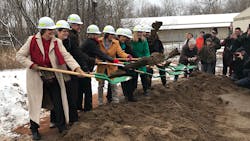MN: Met Council and partners break ground on Southwest LRT
Minnesota's largest infrastructure project in the state's history kicked into high gear with the turning of dirt on Nov. 30; a culmination of more than two decades of planning.
The $2-billion Southwest Light Rail project (Southwest LRT) will extend the existing Green Line, served by Metro Transit, 14.5 miles with 16 stations. The project is expected to create 7,500 construction jobs with an estimated payroll of $350 million.
“This day has been long-awaited and hard-earned,” said Minnesota Gov. Mark Dayton. “The Southwest Light Rail Transit project is a critical economic development project for the people of Minnesota. When complete, it will improve many thousands of lives from Eden Prairie to North Minneapolis. It will create new jobs, reduce highway congestion and better connect Minnesotans to one another."
The Federal Transit Administration (FTA) issued a Letter of No Prejudice for the project in early November, which makes the project eligible for federal reimbursement for early construction work and allowed the Metropolitan Council to award a nearly $800-million construction contract to Lunda/C.S. McCrossan for the project.
The Metropolitan Council explained that early construction activities this winter could include staffing and equipment mobilization, site clearance, demolition and utility work. Heavy construction would occur in 2019-2022, with testing of the system with new light-rail vehicles anticipated in 2022-2023 and passenger service expected in 2023.
The Full Funding Grant Agreement (FFGA) worth $929 million is anticipated in 2019.
In a monthly message, Metropolitan Council Chair Alene Tchourumoff added that the project's rail beds and infrastructure will be built to last at least 50 years before replacement is needed and noted that the "foundation of those tracks rests on the bedrock of sound community partnerships."
“After decades of work, Southwest LRT is becoming a reality," Tchourumoff said at the groundbreaking ceremony. "This project is the result of partnerships, at the federal, state, county, local and community level. Its planning alone has attracted millions of private economic development along the corridor, generating a return on investment before the first shovels even hit the ground. And once it’s built, it will connect thousands of people across the region with jobs, education, opportunities and more.”
Southwest LRT's stations will serve Minneapolis, St. Louis Park, nearby Edina, Hopkins, Minnetonka and Eden Prairie. Once open, it’s expected to see weekday ridership of 34,000. In 2014, there were approximately 64,300 jobs within a half mile of the proposed stations and 126,800 jobs in downtown Minneapolis. By 2035, employment is expected to grow to 80,900 within a half mile of the proposed stations and 145,300 in downtown Minneapolis — an 18 percent increase in employment.
About the Author

Mischa Wanek-Libman
Group Editorial Director
Mischa Wanek-Libman is director of communications with Transdev North America. She has more than 20 years of experience working in the transportation industry covering construction projects, engineering challenges, transit and rail operations and best practices.
Wanek-Libman has held top editorial positions at freight rail and public transportation business-to-business publications including as editor-in-chief and editorial director of Mass Transit from 2018-2024. She has been recognized for editorial excellence through her individual work, as well as for collaborative content.
She is an active member of the American Public Transportation Association's Marketing and Communications Committee and served 14 years as a Board Observer on the National Railroad Construction and Maintenance Association (NRC) Board of Directors.
She is a graduate of Drake University in Des Moines, Iowa, where she earned a Bachelor of Arts degree in Journalism and Mass Communication.
